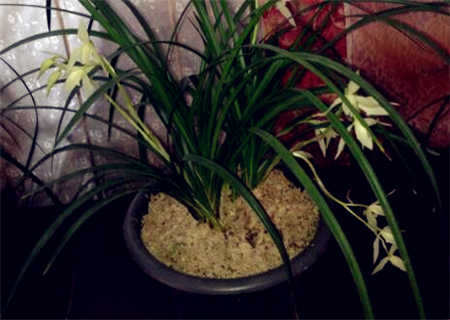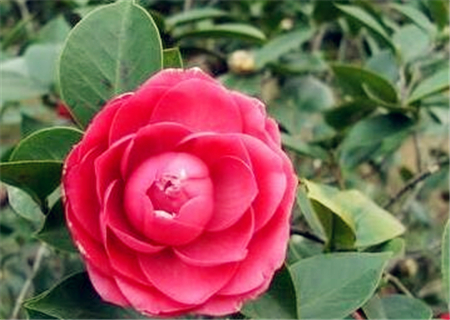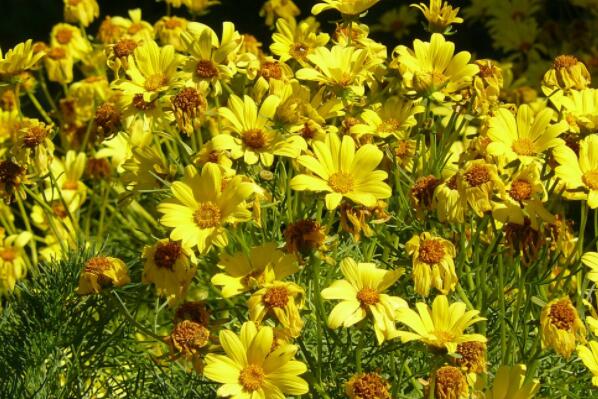How to grow orchids of "Chinese traditional famous flowers"? When will it blossom? What month is the florescence? (when different varieties are in bloom
Orchids in traditional Chinese flowers only refer to several species of terrestrial orchids distributed in Chinese orchids, such as Chunlan, Huilan, Jianlan, Mulan and Hanlan, which are commonly referred to as "Chinese orchids". So how to grow orchids? When will it blossom? What month is the florescence? Details are as follows:

When does the orchid blossom
The flowering time of different orchids is also different. Spring orchids from January to March, ink orchids from December to February, Jianlan from May to October, Huilan from March to May, and cold orchids from November to January. The time of flowering is also different, for example, spring Dendrobium blossoms in spring, autumn Dendrobium blossoms in autumn, and Phalaenopsis should bloom in summer, but it can also bloom during the Spring Festival through greenhouse control.
The reason why orchids do not bloom
1. Under the age of growth: seedlings (seed seedlings) and tissue culture seedlings do not necessarily blossom even if they have been cultivated for many years, just like other plants, such as fruit trees can not blossom and bear fruit until a certain age, orchids can not blossom and bear seeds until a certain age.
2. Varieties are different: species differences among orchids are different, and it is also a common phenomenon that orchids are difficult to blossom due to different climatic conditions. Chunlan, for example, is more difficult to blossom in some areas, or can blossom less.
3. Physiological growth disorder: the physiological growth of orchids is disrupted due to various reasons, and new leaf buds burst during the formation of flower buds. In this case, the orchid plants do not have more nutrients to maintain the normal differentiation of flower buds. As a result, the flower buds stop growing and cannot bloom.
4. Improper cultivation methods: improper cultivation methods may also lead to the failure of orchids to bloom. There are mainly the following two situations.
① soil fertilizer: orchid plant material contains too much nitrogen fertilizer and less phosphorus and potassium fertilizer, which leads to excess vegetative growth and inhibition of reproductive growth. The solution is to replace nitrogen, phosphorus and potassium balanced plant material or increase the application of phosphorus and potassium fertilizer.
Too much watering of ②: too much watering during flower bud differentiation and wet plant materials will also lead to exuberant vegetative growth and inhibit reproductive growth. Because the plant material is too wet, the nutrients contained in the plant material will often be absorbed and transmitted by the root to participate in the metabolism of the plant along with the water. As soon as the metabolism is strong, the respiration will be exuberant, thus counteracting the products of leaf photosynthesis. The organic matter accumulation of orchid plants is affected, and flower bud differentiation is lack of due power.
How to grow orchids
Orchid is a kind of "Jiao" flowers, which can not be raised well if it is not well taken care of in several main aspects, such as water, fertilizer, soil, temperature, light and so on.
One: water means watering. Orchids like cool and damp, but moist refers to the soil to keep moist, not more watering. When the climate is dry, it is appropriate to use a fine-hole spray can to pour the leaves and pot soil to slightly wet, do not water too much, so that the root of the flower stagnant water. When the summer weather is dry, spray water on the leaves. It is better to spray 2Murray 3 times a day. In winter, if the basin soil is not too dry, there is no need to water it. However, we should not make it too dry in spring, summer and autumn.
Two: fat, orchids like fertilizer, but can not stand too much fertilizer. If inorganic fertilizer (chemical fertilizer) is used, it should be diluted and should not be watered more. Use Amoy rice water to store for 1 day and then apply it (watering potted soil, not on the leaves), the amount of fertilizer will be enough to meet the needs of flowers. Soak the peeled apple peels and kernels in water and water the flowers 2 days later, which is more appropriate, because this kind of water and fertilizer is not strong, contains a variety of nutrients, and has a certain acidity, which is suitable for orchids.
Three: soil, that is, the soil for the cultivation of orchids, it is appropriate to use loose soil with sufficient rotten leaf soil or self-made sandy nutrient soil with acid. The pH value is preferably between 5m / m / 6.5 for acid soil.
Four: warm, that is, pay attention to the orchid with a suitable temperature. Orchids like to be cool and avoid muggy heat, but because of their southern origin, they can't stand it.
Frozen, so summer days should pay attention to ventilation and shade or put in a cool and ventilated environment, winter should be placed in a warm place to shelter from the wind, cold winter season should also be moved indoors to avoid frostbite.
Five: light, namely sunlight. Orchids like shade and should not be exposed more. If conditions permit, on sunny days in spring, autumn and winter, move it to the sun from 8 a.m. to 10:00 for 3 hours. Let it bask for half an hour around 8 a.m. in summer, which is good for orchids.
It is particularly noteworthy that orchids are most afraid of coal fumes, which will die as soon as they are smoked. Special attention should be paid to moving orchids indoors in winter.
Florescence Management of Orchid
1. Do not touch the buds: after the buds of orchids are unearthed, do not use your hands to touch and squeeze them. When new orchids are unearthed, they cannot tell whether they are leaf buds or flower buds, so they cannot help but touch and pinch them with their hands. Do not know that the new buds that have just been unearthed are very delicate. Once squeezed by hand, the outer bracts will become "scorched" and even cause flower buds to be "ossified". Therefore, you can only observe them with your eyes, do not squeeze them.
2. According to the growth situation, sparse buds: after the buds come out, the buds should be thinned according to the number of orchid plants and the growth condition, so as to remove the weak and stay strong, such as a pot of spring orchid varieties with only 4 or 5 seedlings, leaving one bud is enough, 8 and 9 seedlings can leave 2 buds, and it doesn't hurt to keep 3 of more than ten seedlings. The author has a pot of 10 seedling grasses, 8 buds, 6 buds and only 2 buds. That's to avoid consuming too much nutrients. The principle of thinning buds is to "remove the weak and stay strong"-buds appear on both the front ridge and the back ridge, preferring to keep the buds of the strong grass in front of the ridge, and only one of the two buds of a strong grass is left after picking off the ridge. the buds that rise from weak seedlings are firmly removed and cannot be preserved, and the buds unearthed too late should also be removed, and those squeezed in the orchid leaves are not as good as those around the orchid plants.
3. Enter the room in the cold winter and spend the winter: put the orchid pot with flower buds in the sunny room to bathe it in warm sunshine. When the temperature rises during the day, you should open the window to breathe and strengthen the ventilation. Daily watering should try to avoid water droplets invading the bracts, so as not to cause decay.
4. Control the dry humidity: when the orchid begins to pull out its stem, it needs a certain amount of water. If there is no humid environment in the pot, the flower stem will not draw high and dwarf the basin, which will be covered by foliage, which is harmful to beauty. In order to raise the scape, the basin must be kept moist and not too dry. If the humidity in the basin is too high, the scape can continue to be raised, but it will often cause the side lobe to "fall" and affect the appearance of the flower. Therefore, the moisture content should be reduced on the eve of Shu valve. However, it cannot be generalized. For some exotic species, such as Chunlan Yu Butterfly, Liang Xi Rui Butterfly, Dance Butterfly, and Huilan Duoyun, Seagull, Bee Qiao, Li Xingrui Butterfly, and so on, they should not be slightly dry, but should be wetter. In order to promote the relaxation of the valve to show the morphological characteristics of the odd valve.
5. Control the light: it is more appropriate to place it where there is scattered light. If the light is too weak, the flowers and colors are not popular in the future, and if you let the direct sunlight (too strong light), the petals after the petals will turn yellow, and even burn easily, which will damage the appearance of the flowers. Especially Suxin orchid, the tongue coating is yellowish when the light is too strong. Therefore, when relaxing the petals of orchids, they should avoid direct sunlight and be placed in places with scattered light.
6. timely flower cutting: the flowering period of orchids is generally more than ten days, and some are as long as a month. Ordinary orchids can bloom as much as possible, but precious orchids will not consume too much nutrients and affect the sprouting of new buds. Spring orchids should be cut at the right time for at most a week after the petals are in full bloom, and the cymbidium with many flowers should be cut off in time 5 or 6 days after it is released from the bottom up.
Time: 2019-03-21 Click:
- Prev

When do the "top ten famous flowers" camellia bloom? What season does it belong to? Attach breeding methods and matters needing attention?
Camellia, also known as camellia, has varying degrees of red, purple, white and yellow flowers, and even colored striped camellias. It is a traditional ornamental flower in China. It ranks seventh among the top ten famous flowers and is also one of the most valuable flowers in the world. So when do camellias bloom? What season does it belong to?
- Next

When does golden rooster chrysanthemum usually sow and blossom? How long is the growth cycle? What are the planting methods?
Chrysanthemum is Compositae, Chrysanthemum belongs to perennial root herbs, also known as small Persian chrysanthemum, chrysanthemum, peacock chrysanthemum. So when does it usually sow and blossom? How long is the growth cycle? What are the planting methods? According to Compositae data, Chrysanthemum morifolium under long sunshine or sufficient light conditions
Related
- Fuxing push coffee new agricultural production and marketing class: lack of small-scale processing plants
- Jujube rice field leisure farm deep ploughing Yilan for five years to create a space for organic food and play
- Nongyu Farm-A trial of organic papaya for brave women with advanced technology
- Four points for attention in the prevention and control of diseases and insect pests of edible fungi
- How to add nutrient solution to Edible Fungi
- Is there any good way to control edible fungus mites?
- Open Inoculation Technology of Edible Fungi
- Is there any clever way to use fertilizer for edible fungus in winter?
- What agents are used to kill the pathogens of edible fungi in the mushroom shed?
- Rapid drying of Edible Fungi

